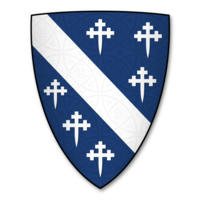Clan Cheyne
| Clan Cheyne | |||
|---|---|---|---|
| Motto | Patientia Vincit (Patience conquers) | ||
| Profile | |||
| District | Aberdeenshire, Caithness and Sutherland | ||
 |
|||
| Clan Cheyne has no chief, and is an armigerous clan | |||
| Historic seat | Esslemont Castle, Aberdeenshire | ||
|
|||
|
|||
|
|||
Clan Cheyne is a Scottish clan. The clan is officially recognized by the Lord Lyon King of Arms, however as the clan does not currently have a chief recognized by the Court of the Lord Lyon, it is therefore considered an Armigerous clan. The surname Cheyne is also recognized as a sept of the Clan Sutherland, and is accepted as such by the Clan Sutherland Society in Scotland.
According to the Collins Scottish Clan & Family Encycleopdia the surname Cheyne is of great antiquity and is believed to have been of either Norman or French origin. The name apparently means Oak Plantation. According to the historian George Fraser Black, some early clerics confused the word for "oak" with that of "dog" and in error they styled the name Canis.
In 1158, Ricardus de Chanai witnessed a gift to the Hospital of St Peter of York. However, the earliest record of the name in Scotland is that of William de Chense who witnessed a charter by William the Lion in about 1200. From 1267 to 1269 Sir Reginald le Chain was Great Chamberlain of Scotland. He held the lands of Inverugie as well as immense estates in Caithness.
In 1320, a later Sir Reginald signed the Declaration of Arbroath.
Historian William Anderson stated that Sir Reginald le Chain who died in 1350 was survived by two daughters. However, as he was renowned as a mighty hunter throughout the land, he longed for a male heir to succeed to his estates, but his wife gave birth to two daughters which Reginald had killed, or at least he thought had had killed. The story goes that as the years passed and no male heir was born, that he saw two young ladies at a festival who far outshined the rest in beauty and accomplishment. He expressed admiration for them to his wife and the cruel fate which had caused to him to order the death of his two daughters, which had they lived would have been about the same age as the two beauties. His wife then introduced him to the two girls, confessing her justifiable disobedience that they were actually his own two daughters. Sir Reginald Cheyne then acknowledged them as heirs to his lands of Esslemont, which had become the principal seat of the family through marriage to the heiress of the Marshall of Esslemont.
...
Wikipedia
